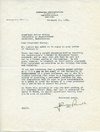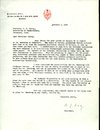“We would do so with joy: ”Gerhard Herzberg
Global events were to have a profound effect on the University of Saskatchewan in the 1930s. A series of circumstances inside those events would eventually bring an up and coming German scientist and future Nobel laureate, Gerhard Herzberg, to the Physics Department. This was another example of how an action by Murray shaped the direction of university research. In this case it would push the small prairie university toward a new interest in the study of light and its various properties.
The Great Depression hit Saskatchewan hard. Economic collapse coupled with drought caused a sharp decline in government revenue. The resulting funding cuts of 1933 forced Murray to take a series of drastic measures. One such measure was to cut staff. President Murray “received authority from the Board to offer those who will not be required, leave of absence for twelve months with three months’ pay." A young Chemistry Professor JWT Spinks fell into the not required category. As a result Dr. Gerhard Herzberg agreed to let Spinks spend 1933-1934 in his laboratory in Darmstadt, Germany. For Spinks, the situation "was just about ideal"- noting, with some understatement, that "Herzberg did very nice experimental work in spectroscopy."
It was a fortunate friendship for the Herzbergs, too – by 1935, the situation in Germany for Dr. Herzberg was becoming increasingly untenable: his wife Luise was Jewish. Spinks approached the Head of Physics, E.L Harrington, who in turn brought the matter up with Murray. Determined to help the Herzbergs, Murray endeavored to find a position for Herzberg outside of Germany, writing to colleagues in Toronto and Ottawa to see if they had openings. "Should neither you feel inclined to invite him to come," Murray stated, "we would do so with joy." It was, as Dr. Spinks later noted, an interesting claim, given that "Murray knew that the bulk of the University assets in 1935 consisted of a bunch of IOUs in his safe!" Murray approached the Carnegie Corporation for funding.  They had no formal system of fellowships, but would give consideration to providing a grant "if you are convinced that a certain German scholar will fill a gap on the staff." Murray obtained a grant of $4,500 - two years' salary. The next hurdle was with Immigration who felt that Herzberg "would not come within the classes ordinarily admissible to Canada” but were persuaded that the arrangement was, indeed, temporary.
They had no formal system of fellowships, but would give consideration to providing a grant "if you are convinced that a certain German scholar will fill a gap on the staff." Murray obtained a grant of $4,500 - two years' salary. The next hurdle was with Immigration who felt that Herzberg "would not come within the classes ordinarily admissible to Canada” but were persuaded that the arrangement was, indeed, temporary.
The Shortt Library of Canadiana and the University museum were both removed from their homes in the Physics building, creating a "Light and special experiments laboratory" and an office for Herzberg. Of more concern to Murray must have been the estimates for equipment costs for Herzberg's research, expected to reach $3,000.00. This and other difficulties were overcome and Gerhard Herzberg stayed at the University of Saskatchewan for 10 years. His work did much to enhance the university’s reputation for research in the physical sciences, and to develop an increased interest in research among students and staff alike.


